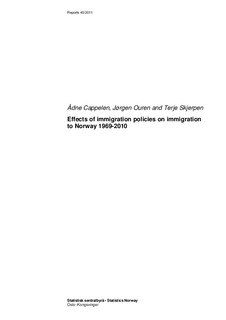| dc.description.abstract | Immigration to Norway increased during the period 1951 - 2010, as did the
emigration from Norway. While during the 1950s there was net emigration most
years, there was a balance during the 1960s while there has been a positive and
increasing net immigration since then. In particular there was a strong increase in
labour immigration following the expansion of the EU in 2004. From the beginning
of the 1970s the Norwegian authorities have implemented several measures to
regulate immigration to Norway. This project examines how changes to regulations
and the economic conditions have influenced this immigration, using statistics for
gross immigration to Norway from, in principle, all countries in the world during
the period 1969 – 2010.
Economic research on migration flows has used one standard model for the
decision to migrate. This model stresses the economic conditions in the country of
residence compared to those in the possible destination country. Expected
differences in earnings will play a role, but the possibilities for finding a job
corresponding to ones level of competence will also be important. The costs of
moving and settling will also play a role when making the decision. These costs are
influenced by cultural and linguistic differences between the countries of origin
and destination. In many situations such economic considerations may have a
limited influence if the person is migrating because of political persecution. In
other cases the decision to migrate may be decided by new or existing family ties. In line with existing studies of immigration we find that economic factors were
important for the immigration to Norway. Income differences between Norway and
other countries have the expected impact, as do differences in income distributions.
The labour market situation in Norway has also been important. Lower
unemployment in Norway has resulted in higher immigration. We do not have
statistics on the labour market situation in all the countries included in this study,
but for the countries with such statistics the results demonstrate that higher
unemployment in the country of origin lead to higher emigration to Norway. ____ (Sammendrag): I perioden fra 1951 til 2010 har innvandringen til Norge vært sterkt økende. Fra å
ha ligget på vel 10 000 per år i slutten av 1950-tallet og begynnelsen av 1960-tallet,
økte innvandringen gradvis og var nærmere 40 000 per år rundt år 2000. Etter
utvidelsen av EU i 2004 har arbeidsinnvandringen igjen økt mye og har svingt
rundt 70 000 de aller siste årene. Mens det var netto utvandring på 1950-tallet, og
om lag null nettoinnvandring på 1960-tallet, har nettoinnvandringen deretter vært
positiv og økende. Fra begynnelsen av 1970-tallet iverksatte myndighetene flere
tiltak for å påvirke innvandringen til Norge. I dette prosjektet analyseres hvordan
ulike politiske tiltak og endringer i økonomiske omstendigheter har påvirket
innvandringen til Norge. Tall for brutto innvandring fra i prinsippet alle land i
verden til Norge fra 1969 til 2010 studeres.
I økonomisk forskning om migrasjonsstrømmer finnes det en slags standardmodell
for hva som påvirker individers beslutning om å flytte eller ei. Her vektlegges
økonomiske forhold i det landet man nå bor i forhold til dit man vurderer å flytte.
Forskjeller i hva man vil tjene spiller en rolle, men også mulighetene for å få seg
arbeid dit man kommer betyr noe. Kostnadene ved å flytte og etablere seg spiller
åpenbart en rolle for om det er verd å flytte. Her kommer kulturelle og språklige
forskjeller inn. I noen sammenhenger har økonomiske forhold liten betydning for
beslutningene fordi man flykter av politiske grunner fra ett land til andre land, eller
det kan være familiære bånd som motiverer flytting. | no_NO |
